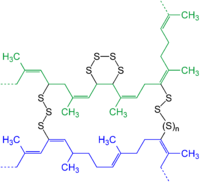
Photo from wikipedia
Cytotoxic blistering agents such as sulfur mustard and nitrogen mustard (HN2) were synthesized for chemical warfare. Toxicity is due to reactive chloroethyl side chains that modify and damage cellular macromolecules… Click to show full abstract
Cytotoxic blistering agents such as sulfur mustard and nitrogen mustard (HN2) were synthesized for chemical warfare. Toxicity is due to reactive chloroethyl side chains that modify and damage cellular macromolecules including DNA and proteins. In response to DNA damage, cells initiate a DNA damage response directed at the recruitment and activation of repair-related proteins. A central mediator of the DNA damage response is p53, a protein that plays a critical role in regulating DNA repair. We found that HN2 causes cytosolic and nuclear accumulation of p53 in HaCaT keratinocytes; HN2 also induced post-translational modifications on p53 including S15 phosphorylation and K382 acetylation, which enhance p53 stability, promote DNA repair, and mediate cellular metabolic responses to stress. HN2 also cross-linked p53, forming dimers and high-molecular-weight protein complexes in the cells. Cross-linked multimers were also modified by K48-linked ubiquitination indicating that they are targets for proteasome degradation. HN2-induced modifications transiently suppressed the transcriptional activity of p53. Using recombinant human p53, HN2 alkylation was found to be concentration- and redox status-dependent. Dithiothreitol-reduced protein was more efficiently cross-linked indicating that p53 cysteine residues play a key role in protein modification. LC-MS/MS analysis revealed that HN2 directly alkylated p53 at C124, C135, C141, C176, C182, C275, C277, H115, H178, K132, and K139, forming both monoadducts and cross-links. The formation of intermolecular complexes was a consequence of HN2 cross-linked cysteine residues between two molecules of p53. Together, these data demonstrate that p53 is a molecular target for mustard vesicants. Modification of p53 likely mediates cellular responses to HN2 including DNA repair and cell survival contributing to vesicant-induced cytotoxicity.
Journal Title: Chemical research in toxicology
Year Published: 2022
Link to full text (if available)
Share on Social Media: Sign Up to like & get
recommendations!